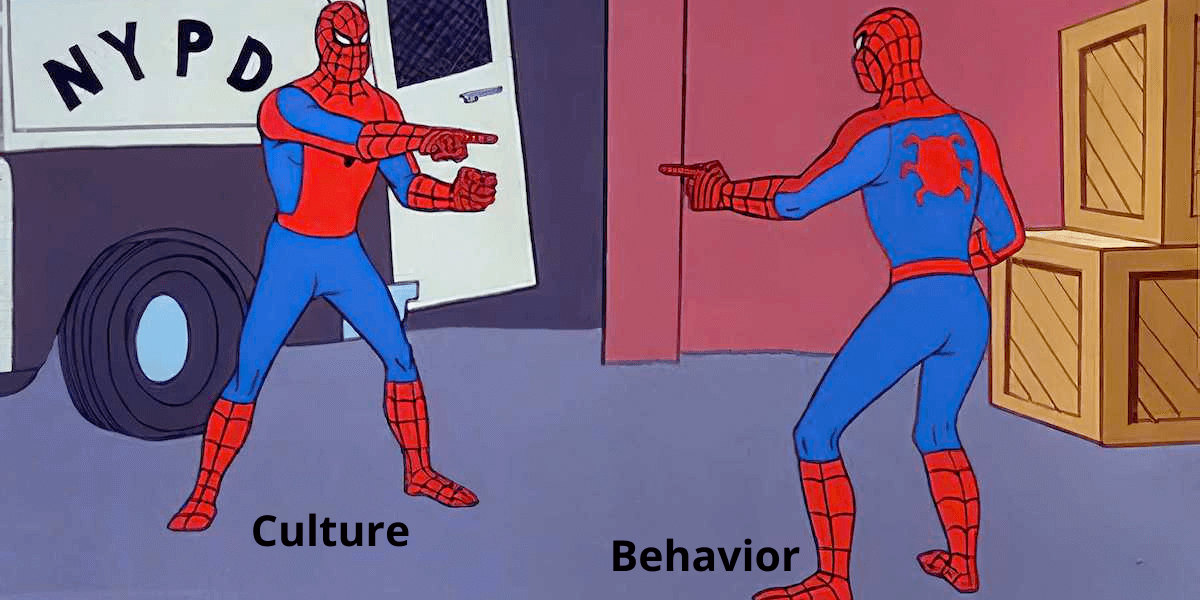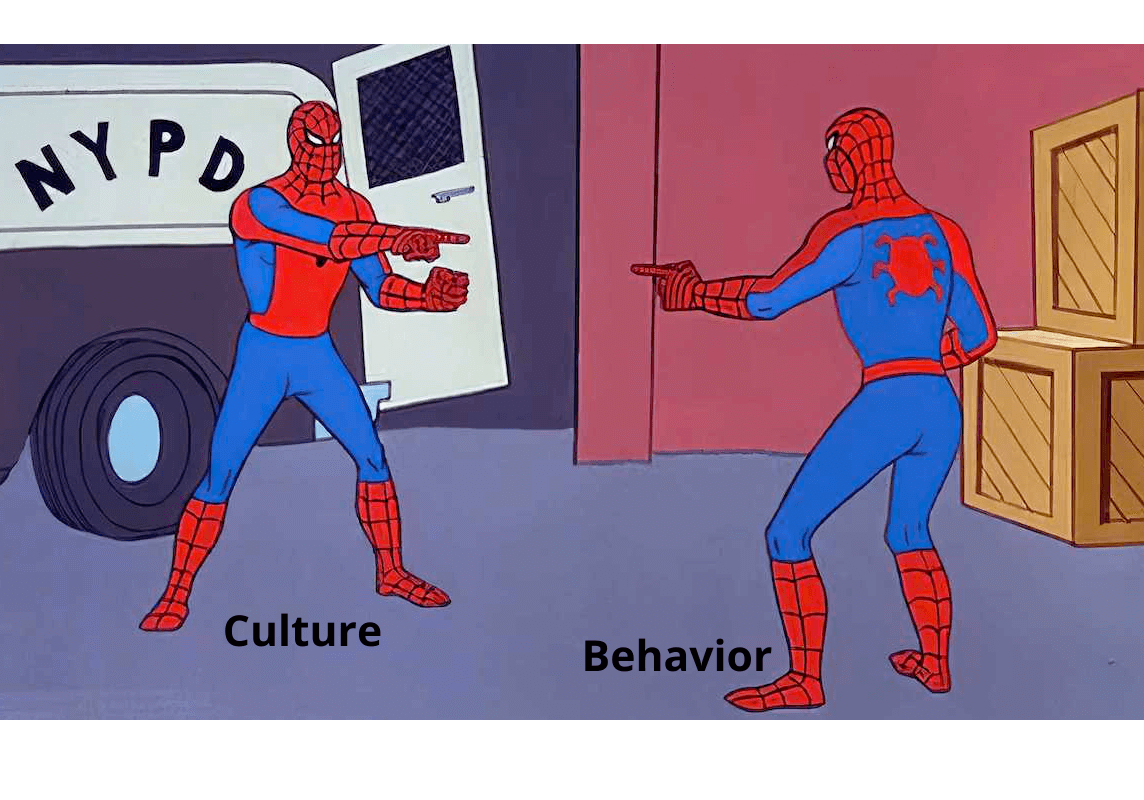Newsletters
In our work with organizations, we hear all sorts of reasons why change won’t work – managers don’t know what they’re supposed to do, there isn’t enough capacity to tackle it right now, there’s no funding. But our favorite one we hear more and more often is, “Our culture would never allow it.”
This is a topic that is near and dear to our hearts because we understand that real transformation can be difficult. We are empathetic to the fact that the tension between what organizations say is their culture and what people actually do within the organization can lead to challenges in getting things done in an efficient and effective manner. This tension is particularly noticeable when we start building ideal future state processes with organizations. The culture they were so proud of suddenly becomes a perceived barrier to making the changes they claim they need.
Our belief is that it is not the culture that’s the problem – it’s the behaviors.
Yes, behaviors are part of the culture. But we believe you can have a positive sounding culture that is corrupted by bad behavior. A common example is when HR says they are a “serving culture.” In their minds, that means they are focused on providing the best customer service for employees and leaders, which is a fantastic culture to aspire to. HR is typically in a support or service-oriented role, so it makes sense. Unfortunately, a serving culture label hides the behavior where HR is so focused on making things “easy” for their customers that they do everything for them. This results in a haphazard, non-standard approach to business processes with HR managing transactional entry for both managers and employees. Everything becomes an exception, and employees and managers don’t know where to even begin to find information.
This is just one example of a good culture gone bad because of behaviors. The good news is that there are actions leaders can take to right the ship:
- Talk about behaviors in a way that encourages change: It’s tempting to approach this in a command-and-control manner or to shame people into changing their behavior. That doesn’t work. Instead, focus on the outcomes you’re trying to achieve and how that impacts or helps them. Challenge perception around the frequency of outlying issues, centering instead on what is happening in the business on a regular basis. While you’re at it, it’s helpful to share examples of how a company similar to yours has already gone through a similar change. This will encourage new behavior as a positive thing to achieve, rather than a negative thing to avoid.
- Hold people accountable: Encouraging change and being positive doesn’t mean you don’t hold people accountable. To hold people accountable, however, you have to be clear about what you are holding them accountable to. Define and communicate your expectations to all employees. Use scorecards and metrics to drive visibility of outcomes. Automate as much as you can to let the system drive accountability through validation and auditing. Ensure each business process has a singular owner and develop an escalation process that limits exceptions and avoids senior leadership overriding the purpose of the standard process.
We feel so strongly about this topic, we even did a webinar on it! For more information on how behaviors (not culture!) derail your transformation efforts, click here.
No matter how you describe your culture, it is meaningless unless the behaviors within the organization support good business process.
With warm regards,
— Kimberly Carroll
Managing Partner/Behaviorist, IA
Voice of HR

The provider / client relationship: Part II – addressing bullying behaviors
In this follow up post about the challenges of bullying behavior between providers and clients, Kimberly Carroll and Corrina Nation recommend actions to improve the relationship.
Where You Can Find Us

Summer has been zipping along and our Fall calendar is starting to look exciting! We hope you can join us for the following events:
- August 4-5, 2022: Mark Stelzner has been invited to keynote at TechHR India 2022. The conference theme is #FreshEyes.
- September 13-16, 2022: Once again, IA is pleased to support the HR Tech Conference in Las Vegas. IA-ers are participating in Women in HR Tech, the pre-conference sessions, and a mega-session during the main event! We hope to see you there!
- November 7-9, 2022: Mary Faulkner will be moderating a panel at ERE’s in-person Fall Recruiting Conference. More details to come.
- November 17, 2022: IA is pleased to support the upcoming Scalefest ONE – the virtual transformation event that follows the sun. Planning is still underway with more details coming soon!
On Our Radar
July was a shorter month for our team as we honored our shutdown week during the 4th of July holiday. So while there was a lot of terrific content out there, we were more focused on sharing pictures of our travels and embracing the recharge a company-wide shutdown can bring. But don’t think for a moment that we didn’t find some articles to share:
- This article from Harvard Business Review hit a little differently after we all returned from shutdown. It is difficult for a group of overachievers to accept that you’ll never fully catch up with work, but the reality is work will always be there – so why feel guilty about it?
- While ostensibly about the failed deal between Elon Mush and Twitter, this piece from Inc.com is really about the difference between dreaming and doing. It’s a fascinating lens through which to consider visionaries.
- And finally, what’s life without a little laughter? We came across this collection of consulting “truths” that made us chuckle. As the anti-consulting consultants, we couldn’t agree more.
About IA
As trusted advisors to senior leaders, IA supports strategic initiatives that transform the way organizations work.
Our seasoned team of professionals apply a revolutionary eye, deep domain experience, and flexible tools to accelerate the achievement of even the most ambitious goals. With a cross-functional, strategic perspective, we thrive on big, messy problems. Whether large or small, public or private, domestic or international, it’s our job to support leaders and their teams in achieving outcomes that are truly unique to their culture and objectives.
Every organization has a catalyst for change – learn more at ia-hr.com.






